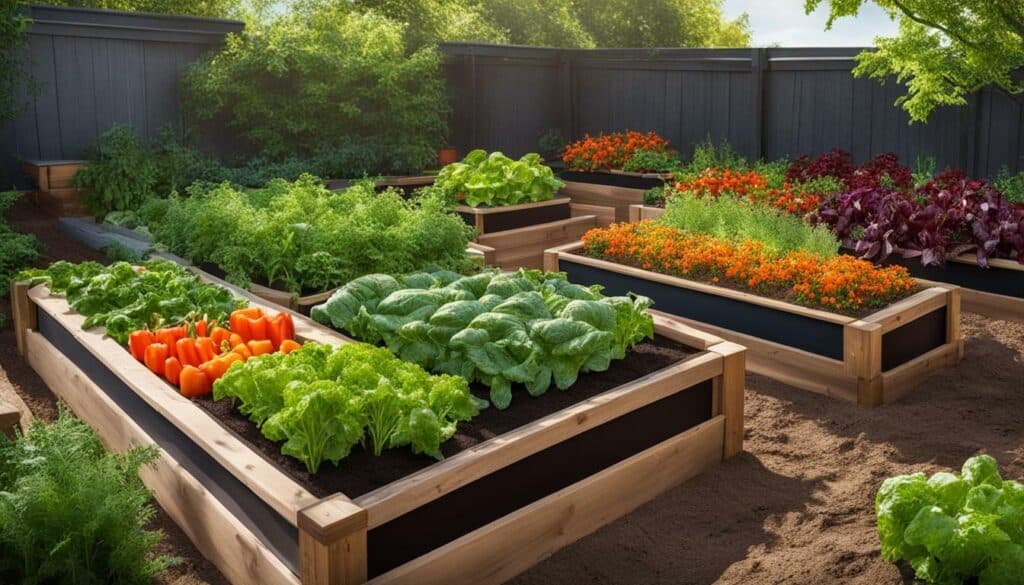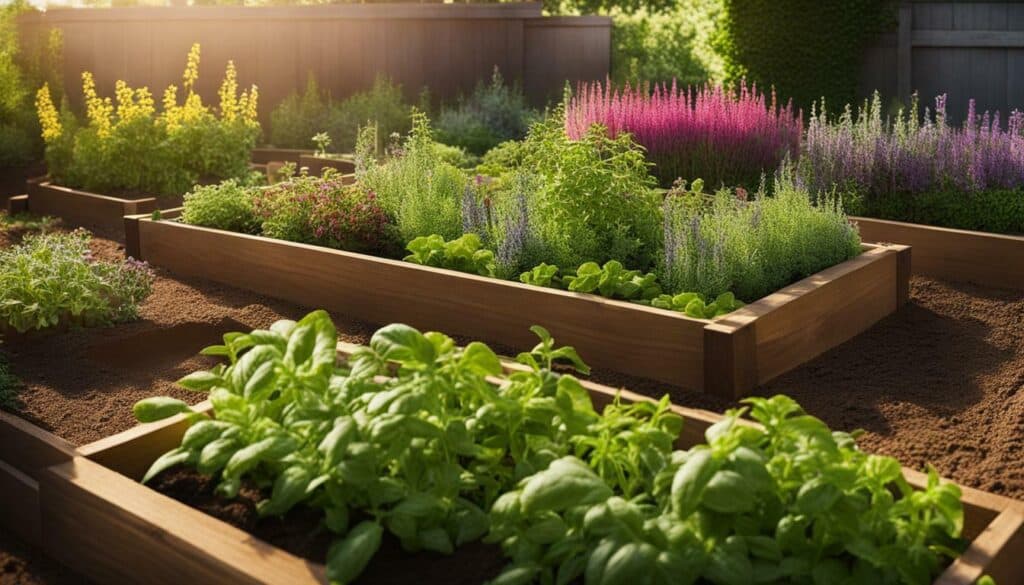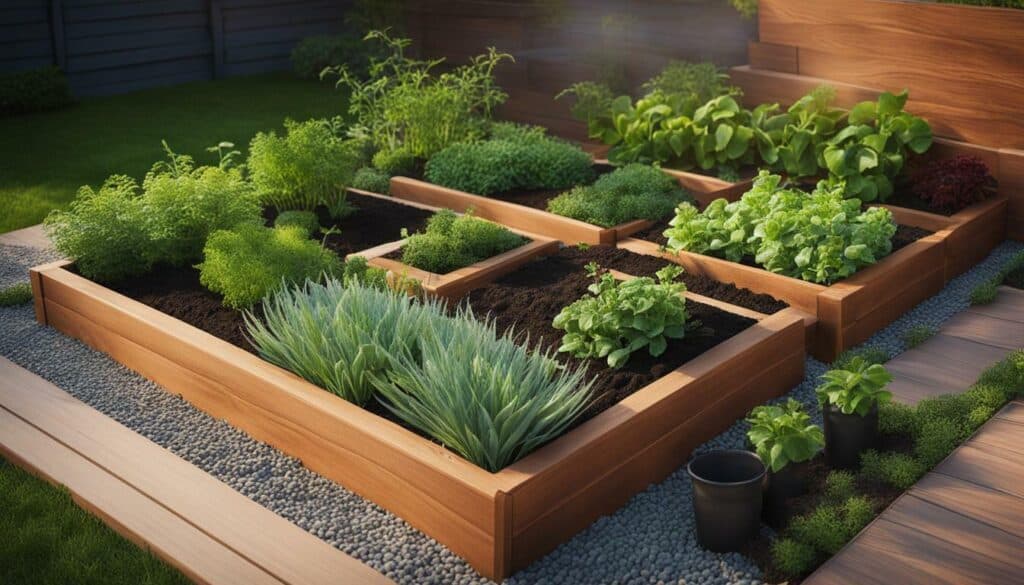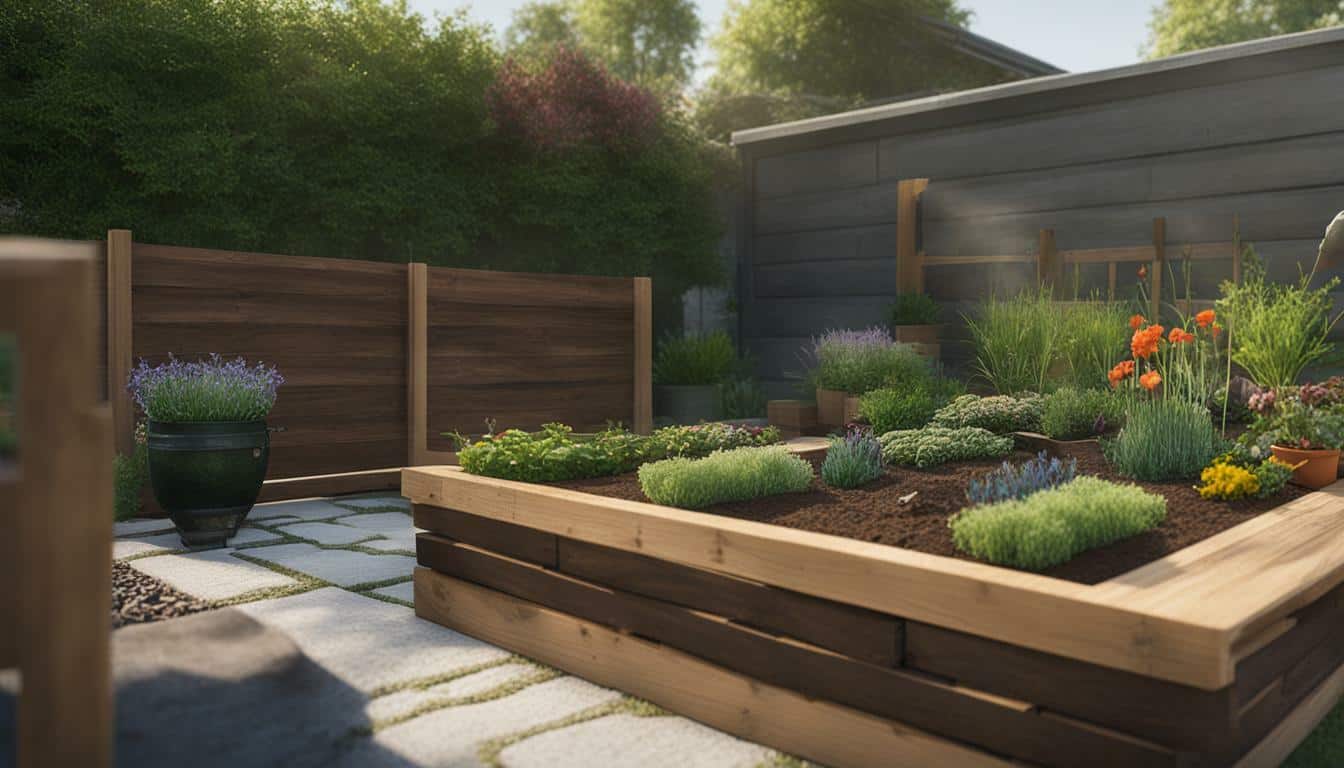Raised bed gardening has become popular due to its space-saving benefits and the ability to have control over the quality of soil used. It is a great option for those with limited time, space, or physical ability.
Raised beds can be constructed from a variety of materials, including wooden railroad ties, old feed bunks, or tractor tires, and can be customized to fit the available space. The type of soil used in raised beds can vary depending on personal preference and access to resources.
When starting a raised bed garden, it is important to choose a location that receives at least six hours of direct sunlight and is easily accessible for maintenance and irrigation. With proper care and attention, raised bed gardening can be a productive and beautiful way to grow a variety of plants and vegetables.
Key Takeaways:
- Raised bed gardening is a popular and efficient way to grow a garden.
- There are several benefits to using raised beds, including saving space, using better soil, and reducing physical strain.
- Raised beds can be constructed from a variety of materials, and the type of soil used can vary depending on personal preference and access to resources.
- When starting a raised bed garden, it is important to choose a location that receives at least six hours of direct sunlight and is easily accessible for maintenance and irrigation.
Choosing the Right Materials for Raised Beds
When starting a raised bed garden, it’s important to choose the right materials for your beds. Raised beds offer several advantages, such as saving space, using better soil, and reducing the physical strain of gardening. In order to ensure your raised beds are successful, it is recommended to consider the width, height, and shape of the beds.
Materials like non-treated, rot-resistant lumber, bricks, rocks, cinder blocks, and plastic decking can be used for construction. It is important to avoid treated lumber as it can release harmful chemicals into the soil. Additionally, the bed should be at least six to eight inches high, allowing for proper root growth and drainage.
As for the soil, a combination of quality garden soil and compost is ideal, with compost making up 10-20% of the total soil volume. It is important to ensure the soil is tested and proper amendments are added. Adding organic matter like compost can help improve drainage and boost nutrient levels.
Raised beds should be placed in a spot that receives at least six hours of direct sunlight daily and should be located near a water source for easy irrigation. When starting a raised bed garden, it’s important to choose materials that will ensure the success of your plants. With the right construction and soil mix, your raised beds can thrive for years to come.
Selecting the Perfect Soil Mix for Raised Beds
Designing your raised bed garden involves selecting the perfect soil mix. Raised beds offer a great opportunity to create a customized soil blend that is tailored to the specific needs of your garden. The benefits of raised bed gardening are many, including better soil quality, improved drainage, and increased yield. In order to maximize these benefits, it is important to select the right soil mix for your raised beds.
| Soil Selection Tips for Raised Beds |
|---|
| 1. Combine Quality Soil and Compost When selecting soil for your raised beds, aim for a 50-50 mix of quality garden soil and compost. Compost will add organic matter and nutrients to the soil, while the garden soil provides a stable base for plant roots. |
| 2. Consider Raised Bed Construction Material The construction material of your raised beds can also influence your soil mix. It is recommended to avoid treated lumber, as it can leach harmful chemicals into the soil. Instead, opt for non-treated, rot-resistant lumber or other suitable materials like bricks or plastic decking. |
| 3. Proper Placement Proper placement of your raised beds is crucial. Ensure they receive at least six hours of direct sunlight and are conveniently located near a water source. Consider the slope of your land and ensure your beds are level for optimal drainage. |
Remember, different crops require different soil nutrients. Consider dividing your raised beds into sections, each with a customized soil mix to support the specific crops you plan to grow. Raised beds offer an efficient and manageable gardening space for both experienced and novice gardeners. By selecting the right soil mix and construction materials, you can create a highly productive garden that will flourish for years to come.

Benefits of Raised Beds for Gardening Enthusiasts
Raised beds offer numerous benefits for gardening enthusiasts, including those who enjoy growing herbs. One advantage of raised beds is that they make gardening easier on the body. Rather than kneeling or bending over, plants are grown within arm’s reach, making it easier to tend to them. This feature is particularly beneficial for those who have physical limitations or are older. In addition, raised beds offer a neater garden appearance. Plants are grown in contained beds, making it easier to maintain a tidy garden.
Another benefit of raised bed gardening is the reduced risk of soil contamination. Traditional gardening can be difficult in areas with poor soil quality or soil that may be contaminated. Raised beds offer the advantage of using better soil for growing crops.
Raised beds also warm up quicker in spring, allowing for earlier planting times. This is especially important for those who live in cooler climates or want to get a head start on their planting season. Raised beds also provide better drainage and can be customized to specific soil needs for each crop.
Overall, raised beds offer a practical and efficient option for gardening enthusiasts, including those who enjoy growing herbs. They offer a more comfortable and organized way of gardening, allowing for better control over the soil and plant growth. Despite the initial costs and need to purchase soil, raised beds are a valuable investment for those who want to enjoy a successful and productive gardening experience.

Comparing Raised Beds to Intensive Gardening
For beginners in vegetable gardening, it’s important to compare raised beds to intensive gardening on level ground. Raised beds offer space-saving benefits and control over soil quality, making them a great option for those with limited time, physical abilities, or poor soil conditions. However, they require purchasing soil and can be more expensive to construct. They may also dry out more quickly, requiring more frequent watering.
Intensive gardening, on the other hand, involves growing crops closely together to maximize productivity. This can be done on level ground or without side walls, making it a viable alternative to raised beds. Intensive gardening does not necessarily require raised beds to achieve increased productivity.
When it comes to construction, raised beds can be built using a variety of materials, such as non-treated, rot-resistant wood, bricks, rocks, cinder blocks, or plastic decking material. The beds should ideally be no more than four feet wide for easy access and be at least six inches tall to accommodate plant roots.
In terms of soil, a combination of garden soil and compost is often used to fill raised beds. Soil tests should be conducted to determine proper amendments. It is recommended to aim for no more than 50% organic matter, with compost making up 10-20% of the total soil volume.
When selecting the perfect location for a raised bed garden, consider an area that receives at least six hours of direct sunlight each day. It is also beneficial to have the beds located near a water source for ease of irrigation.
Ultimately, the decision to use raised beds or adopt intensive gardening techniques depends on individual preferences and specific garden requirements. Both methods offer their own advantages and considerations to take into account.

Conclusion
In conclusion, raised bed gardening offers numerous benefits and is a practical and efficient option for those interested in vegetable gardening. With limited space, physical ability, or poor quality soil, raised beds allow for better soil control and can save space. They eliminate the need for bending over and pulling weeds, making gardening easier. Raised beds can also be customized using various materials and provide an opportunity to grow different crops in separate beds.
While raised beds can be more expensive and require more frequent watering, they are generally easier to maintain and can result in higher productivity. Proper construction and soil preparation are key to ensuring success. With the right soil mix, you can grow a variety of crops, including herbs, vegetables, and fruits.
If you’re interested in starting a garden but don’t have much experience, raised bed gardening is a practical and efficient option. With its many benefits, you’ll enjoy fresh produce and a tidy garden, all with minimal effort. Give it a try today and see how raised bed gardening can make a difference in your life!
FAQ
Q: What is raised bed gardening?
A: Raised bed gardening is a method of growing plants in beds that are raised above the ground. It is popular for its space-saving benefits and the ability to have control over the quality of soil used.
Q: What materials can be used to construct raised beds?
A: Raised beds can be made with various materials such as wooden railroad ties, feed bunks, or tractor tires. The choice of materials depends on personal preference and availability.
Q: What soil mix should I use for raised beds?
A: The ideal soil mix for raised beds is a combination of potting mix, traditional soil, and compost. This creates a fertile environment for plants to thrive. Different crops can be grown in different beds, allowing for customized soil nutrients.
Q: What are the benefits of raised beds for gardening enthusiasts?
A: Raised beds offer several benefits for gardening enthusiasts. They require less bending over, making them ideal for people with sore muscles or back trouble. Raised beds also create a neater garden appearance and warm up quicker in spring. Additionally, they can be used in areas with poor soil or contamination.
Q: How do raised beds compare to intensive gardening?
A: Raised beds are often claimed to be more productive than intensive gardening on level ground. However, it is important to consider the higher initial costs associated with raised beds, as well as the need to purchase soil. Despite these factors, raised beds remain a practical and efficient option for beginners in vegetable gardening.
Can I Use Hydroponic Gardening Techniques in Raised Bed Gardening?
Raised bed gardening is a popular technique, but can we incorporate mastering hydroponic gardening indoors into it? While hydroponics typically involves water-based cultivation, raised beds rely on soil. Although not a traditional combination, some avid gardeners have experimented successfully, using hydroponic methods to create nutrient-rich solutions and deliver it to the plant roots within the raised beds.
Source Links
- https://farmfitliving.com/raised-bed-gardening-101/
- https://www.gardenfundamentals.com/raised-beds-pros-cons/
- https://extension.unh.edu/blog/2019/03/what-are-benefits-raised-beds-how-can-i-construct-one-myself
- https://www.gardeners.com/how-to/raised-bed-basics/8565.html
- https://www.homefortheharvest.com/raised-bed-gardening/
- https://www.amazon.com/Raised-Bed-Gardening-Beginners-Everything/dp/1641525096
- https://www.gardeners.com/how-to/materials-for-raised-beds/9578.html
- https://joegardener.com/podcast/raised-bed-gardening-pt-1/
- https://joegardener.com/podcast/raised-bed-gardening-pt-2/
- https://www.planetnatural.com/raised-bed-soil/
- https://journeywithjill.net/gardening/2020/03/09/3-raised-bed-soil-mixes-compared/
- https://ngb.org/raised-bed-gardening-benefits/
- https://savvygardening.com/benefits-of-raised-garden-beds/
- https://extension.uga.edu/publications/detail.html?number=C1027-3&title=raised-beds-vs-in-ground-gardens
- https://www.gardenary.com/blog/why-you-should-practice-intensive-planting-in-your-organic-kitchen-garden
- https://gardeningsolutions.ifas.ufl.edu/design/types-of-gardens/raised-beds.html
- https://extension.missouri.edu/publications/g6985





Leave a Reply